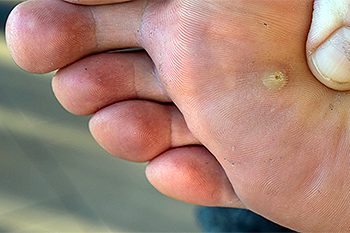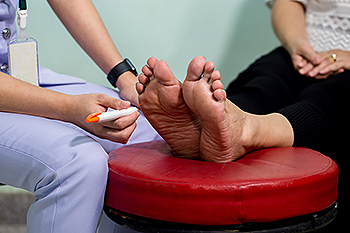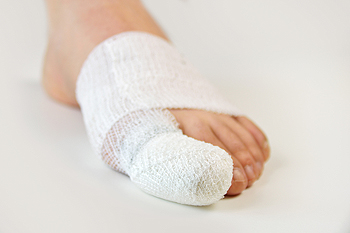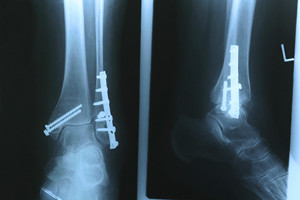Connect With Us
Blog
Items filtered by date: May 2022
Why Do Corns Develop?

A corn is a skin lesion, usually caused by excess friction that comes from wearing shoes and socks that are too tight. It is defined as a small, hardened area of skin that can be quite painful. A hard corn generally develops on top of the toes, or on the side of the pinky toe. Additionally, they may form on the top of a hammertoe or bunion. Corns that form between the toes are referred to as soft corns, and stay moist from the sweat that accumulates there. Effective prevention methods can include wearing shoes that fit correctly, and some patients find it helpful to separate the toes by using lamb’s wool or moleskin. It may be beneficial for people who are prone to developing soft corns to purchase larger shoes that may help to keep the toes apart. Corns can develop in patients who frequently wear high heels, a result of having limited space for the toes to move. If you have a corn on your foot, it is suggested that you speak with a podiatrist who can effectively treat this ailment.
If you have any concerns regarding your feet and ankles, contact Jeffrey L. Bober, DPM of Maryland. Our doctor will treat your foot and ankle needs.
Corns: What Are They? and How Do You Get Rid of Them?
Corns can be described as areas of the skin that have thickened to the point of becoming painful or irritating. They are often layers and layers of the skin that have become dry and rough, and are normally smaller than calluses.
Ways to Prevent Corns
There are many ways to get rid of painful corns such as wearing:
- Well-fitting socks
- Comfortable shoes that are not tight around your foot
- Shoes that offer support
Treating Corns
Treatment of corns involves removing the dead skin that has built up in the specific area of the foot. Consult with Our doctor to determine the best treatment option for your case of corns.
If you have any questions please feel free to contact our office located in Glen Burnie, MD . We offer the newest diagnostic and treatment technologies for all your foot and ankle needs.
Plantar Warts in Children

Warts are areas of hardened skin that typically have a bumpy surface. They come in various sizes, shapes, and colors and can appear anywhere on the body. Plantar warts occur on the bottom of the feet. Children get them more often than adults. Viruses from the human papillomavirus (HPV) cause warts. Kids can get warts from touching a towel or surface that someone else with a wart has used and pick up HPV. Warts thrive in warm, moist environments like the feet. Plantar warts can grow for a long time before they are visible. Walking barefoot in public places and not cleaning and drying the feet well regularly makes one more susceptible to plantar warts. These warts can cause considerable discomfort and feel like there is a rock in one’s shoe. One should not pick at, rub, or scratch a wart. Most of the time, these warts will go away on their own, but they can recur. Plantar warts can be treated with medicine containing mild acid that removes dead skin cells on the wart, cryosurgery - where the doctor uses a chemical repeatedly across a few weeks to freeze the wart and kill the virus, or other means of removing the wart. It is a good idea to take your child to a podiatrist to have the plantar wart treated and not try to remove it on your own.
Plantar warts can be very uncomfortable. If you need your feet checked, contact Jeffrey L. Bober, DPM from Maryland. Our doctor will assist you with all of your foot and ankle needs.
About Plantar Warts
Plantar warts are the result of HPV, or human papillomavirus, getting into open wounds on the feet. They are mostly found on the heels or balls of the feet.
While plantar warts are generally harmless, those experiencing excessive pain or those suffering from diabetes or a compromised immune system require immediate medical care. Plantar warts are easily diagnosed, usually through scraping off a bit of rough skin or by getting a biopsy.
Symptoms
- Lesions on the bottom of your feet, usually rough and grainy
- Hard or thick callused spots
- Wart seeds, which are small clotted blood vessels that look like little black spots
- Pain, discomfort, or tenderness of your feet when walking or standing
Treatment
- Freezing
- Electric tool removal
- Laser Treatment
- Topical Creams (prescription only)
- Over-the-counter medications
To help prevent developing plantar warts, avoid walking barefoot over abrasive surfaces that can cause cuts or wounds for HPV to get into. Avoiding direct contact with other warts, as well as not picking or rubbing existing warts, can help prevent the further spread of plantar warts. However, if you think you have developed plantar warts, speak to your podiatrist. He or she can diagnose the warts on your feet and recommend the appropriate treatment options.
If you have any questions please feel free to contact our office located in Glen Burnie, MD . We offer the newest diagnostic and treatment technologies for all your foot and ankle needs.
Suggested Foot Care for Diabetics

Diabetics who have long battled with high blood sugar levels are top candidates for foot problems that develop because of nerve damage and constricted blood flow to the feet and toes. These conditions often cause numbness that makes it difficult for the diabetic to detect hot and cold sensations, notice sores on their feet, and feel pressure from shoes that are too tight. Practicing foot care is a must for diabetics. Suggested tasks include checking for cuts, sores, wounds that don’t seem to be healing, calluses, corns, and cracks in the skin. These can all develop into ulcers that may cause serious problems, such as gangrene or even amputation, if ignored. Other measures include keeping the feet washed, thoroughly dried, and moisturized daily. Also, groom toenails properly by cutting them, or having them cut, straight across to prevent ingrown toenails that may invite infection. Protect your feet by wearing socks that are clean and dry and try to avoid walking barefoot. Anyone with diabetes would be wise to make regular visits to a podiatrist, who can evaluate their feet and keep current with necessary treatment options.
Diabetic foot care is important in preventing foot ailments such as ulcers. If you are suffering from diabetes or have any other concerns about your feet, contact Jeffrey L. Bober, DPM from Maryland. Our doctor can provide the care you need to keep you pain-free and on your feet.
Diabetic Foot Care
Diabetes affects millions of people every year. The condition can damage blood vessels in many parts of the body, especially the feet. Because of this, taking care of your feet is essential if you have diabetes, and having a podiatrist help monitor your foot health is highly recommended.
The Importance of Caring for Your Feet
- Routinely inspect your feet for bruises or sores.
- Wear socks that fit your feet comfortably.
- Wear comfortable shoes that provide adequate support.
Patients with diabetes should have their doctor monitor their blood levels, as blood sugar levels play such a huge role in diabetic care. Monitoring these levels on a regular basis is highly advised.
It is always best to inform your healthcare professional of any concerns you may have regarding your feet, especially for diabetic patients. Early treatment and routine foot examinations are keys to maintaining proper health, especially because severe complications can arise if proper treatment is not applied.
If you have any questions please feel free to contact our office located in Glen Burnie, MD . We offer the newest diagnostic and treatment technologies for all your foot and ankle needs.
Treatment Options for a Broken Toe

Usually, a broken toe is not a serious foot condition, despite the fact it can cause severe pain and discomfort. Common ways to break a toe include jamming it against a piece of furniture or dropping a heavy object on it. Many patients notice immediate pain, bruising and swelling, and the affected toe is often difficult to move. In severe fractures, the toe may protrude at an uncomfortable angle, and may require an aggressive form of treatment. The bone may need to be moved back into place, and this is referred to as reduction. Relief may be found when the broken toe is taped to the toe next to it, which can provide the stability that is necessary as the healing process occurs. This method, referred to as buddy taping, is fairly easy to accomplish. Surgery may be a viable treatment option if the break is severe, in addition to possible wearing a cast that can provide added support. If you have broken a toe, you may with to visit a podiatrist for a complete examination and treatment options.
A broken toe can be very painful and lead to complications if not properly fixed. If you have any concerns about your feet, contact Jeffrey L. Bober, DPM from Maryland. Our doctor will treat your foot and ankle needs.
What to Know About a Broken Toe
Although most people try to avoid foot trauma such as banging, stubbing, or dropping heavy objects on their feet, the unfortunate fact is that it is a common occurrence. Given the fact that toes are positioned in front of the feet, they typically sustain the brunt of such trauma. When trauma occurs to a toe, the result can be a painful break (fracture).
Symptoms of a Broken Toe
- Throbbing pain
- Swelling
- Bruising on the skin and toenail
- The inability to move the toe
- Toe appears crooked or disfigured
- Tingling or numbness in the toe
Generally, it is best to stay off of the injured toe with the affected foot elevated.
Severe toe fractures may be treated with a splint, cast, and in some cases, minor surgery. Due to its position and the pressure it endures with daily activity, future complications can occur if the big toe is not properly treated.
If you have any questions please feel free to contact our office located in Glen Burnie, MD . We offer the newest diagnostic and treatment technologies for all your foot and ankle needs.
Get Professional Care for a Broken Foot or Ankle
What Are Stress Fractures?

Stress fractures are bone breaks that happen more subtly than one would usually think of when imagining broken bones. They are caused by repetitive movement on or by a bone over time. These fractures can either be hairline fractures or total breaks. Common areas of the body for stress fractures to occur include the shin, thigh, pelvis, and feet. Anyone can be affected by stress fractures but they are most commonly seen in athletes, healthcare workers, and military personnel. Generally, this type of fracture is caused by overuse. While the body is constantly repairing itself, certain actions prevent the body from normal healing. Feet need ample time to rest and repair or one can be prone to fractures. Other possible causes of bone breaks include osteoporosis, wearing improper footwear (too tight, too high, or not supportive), misaligned bones or muscles, obesity, and using oral steroids. If you experience foot pain that is not going away in a reasonable time frame, visit a podiatrist to see if you have developed a stress fracture.
Activities where too much pressure is put on the feet can cause stress fractures. To learn more, contact Jeffrey L. Bober, DPM from Maryland. Our doctor can provide the care you need to keep your pain free and on your feet.
Dealing with Stress Fractures of the Foot and Ankle
Stress fractures occur in the foot and ankle when muscles in these areas weaken from too much or too little use. The feet and ankles then lose support when walking or running from the impact of the ground. Since there is no protection, the bones receive the full impact of each step. Stress on the feet can cause cracks to form in the bones, thus creating stress fractures.
What Are Stress Fractures?
Stress fractures occur frequently in individuals whose daily activities cause great impact on the feet and ankles. Stress factors are most common among:
- Runners
- People affected with Osteoporosis
- Tennis or basketball players
- Gymnasts
- High impact workouts
Symptoms
Pain from the fractures occur in the area of the fractures and can be constant or intermittent. It will often cause sharp or dull pain with swelling and tenderness. Engaging in any kind of activity which involves high impact will aggravate pain.
If you have any questions please feel free to contact our office located in Glen Burnie, MD . We offer the newest diagnostic and treatment technologies for all your foot and ankle needs.
Blog Archives
- April 2025
- March 2025
- February 2025
- January 2025
- December 2024
- November 2024
- October 2024
- September 2024
- August 2024
- July 2024
- June 2024
- May 2024
- April 2024
- March 2024
- February 2024
- January 2024
- December 2023
- November 2023
- October 2023
- September 2023
- August 2023
- July 2023
- June 2023
- May 2023
- April 2023
- March 2023
- February 2023
- January 2023
- December 2022
- November 2022
- October 2022
- September 2022
- August 2022
- July 2022
- June 2022
- May 2022
- April 2022
- March 2022
- February 2022
- January 2022
- December 2021
- November 2021
- October 2021
- September 2021

